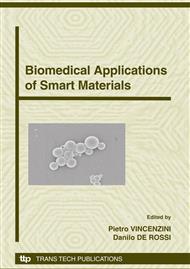p.204
p.210
p.216
p.220
p.226
p.235
p.241
p.247
p.257
Theory and Experiments for Mechanically-Induced Remodeling of Tissue Engineered Blood Vessels
Abstract:
There is a great unmet clinical need to develop small diameter tissue engineered blood vessels (TEBV) with low thrombogenicity and immune response and suitable mechanical properties. In this paper we describe experimental and computational frameworks to characterize the use of mechanical stimuli to improve the mechanical properties of TEBVs. We model the TEBV as a constrained mixture and track the production, degradation, mechanical state, and organization of each structural constituent. Specifically, we assume that individual load bearing constituents can co-exist within each neighborhood and, although they are constrained to deform together, each constituent within this neighborhood may have different natural (i.e., stress-free) configurations. Motivated by this theoretical framework, we have designed a bioreactor and biomechanical testing device for TEBVs. This device is designed to provide precise and independent control of mean and cyclic luminal flow rate, transmural pressure, and axial load over weeks and months in culture and perform intermittent biaxial biomechanical tests. This device also fits under a two-photon laser scanning microscope for 3-dimenstional imaging of the content and organization of cells and matrix constituents. These data directly support our theoretical model.
Info:
Periodical:
Pages:
226-234
Citation:
Online since:
September 2008
Authors:
Keywords:
Price:
Сopyright:
© 2008 Trans Tech Publications Ltd. All Rights Reserved
Share:
Citation:


